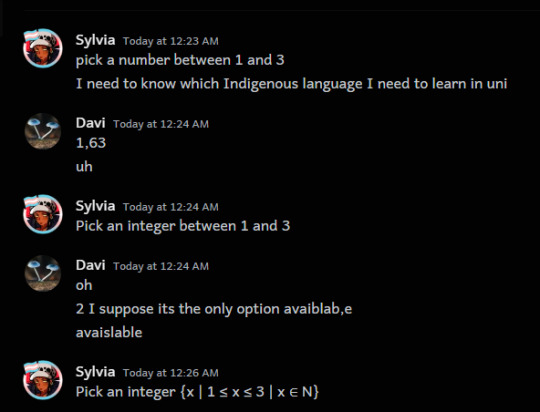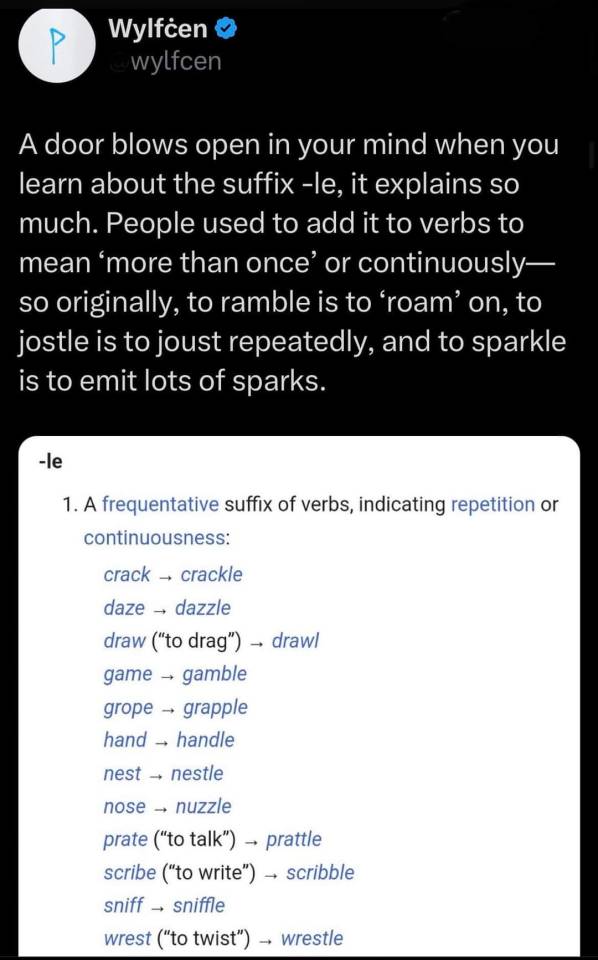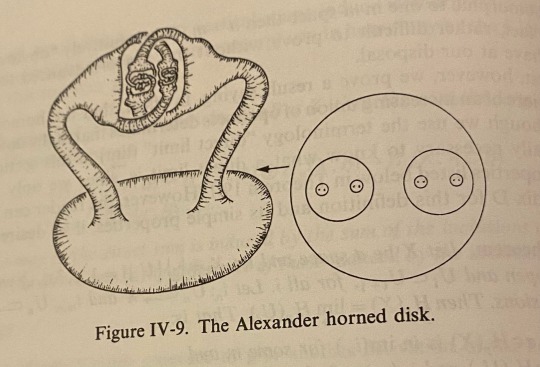Text

Guide For The Geological Time Periods In Order
9K notes
·
View notes
Text
Three households, all without utilities
Upon a torus where we lay our scene
223 notes
·
View notes
Text
you can't spell QED without RAT DEMON

985 notes
·
View notes
Text
Happy pi day to the greatest video of all time
8K notes
·
View notes
Text
I was far too sleepy to look for it yesterday but I have done so now: This is known as Craig's Theorem.

A type of mathematical reasoning that is obviously deductively valid, but which for reasons inscrutable to me I never quite trust, is when you want to prove something about the members of a set X, so you construct a superset Y of X and then prove that the proposition holds for members of Y. This is the most unobjectionable thing in the world but at some level it feels like bullshit to me. It just feels like bullshit. Note that it feels totally fine if you had Y to start with and merely passed down to a subset X.
But like. Sometimes you prove some shit about the integer solutions to a polynomial by passing to the rational numbers or the complex numbers or whatever, and clearly this works but I hate it. It's like, at some level I feel that the complex numbers "don't exist" in the integers-worlds, and so they shouldn't be able to say anything about them. Structural set theory ass intuition.
225 notes
·
View notes
Text
This is a technique that I like to call 'proof by cheating'. My favourite example is the proof that any reursively enumerable theory has an equivalent recursive theory.
A type of mathematical reasoning that is obviously deductively valid, but which for reasons inscrutable to me I never quite trust, is when you want to prove something about the members of a set X, so you construct a superset Y of X and then prove that the proposition holds for members of Y. This is the most unobjectionable thing in the world but at some level it feels like bullshit to me. It just feels like bullshit. Note that it feels totally fine if you had Y to start with and merely passed down to a subset X.
But like. Sometimes you prove some shit about the integer solutions to a polynomial by passing to the rational numbers or the complex numbers or whatever, and clearly this works but I hate it. It's like, at some level I feel that the complex numbers "don't exist" in the integers-worlds, and so they shouldn't be able to say anything about them. Structural set theory ass intuition.
225 notes
·
View notes
Text

Highly specific LaTeX posting
745 notes
·
View notes
Note
Some neural nets trained to try and help with the classification of rank of an elliptic curve problem. Called murmurations because it looks like bird flight patterns.

Were you involved in the murmurations stuff at all? I heard a talk about it today and, coincidentally, some of your posts have just shown up on my dash.
Murmurations as in large bird flock flight patterns? Or is that someone's handle, or?
This is the first I'm hearing of it so I don't think so.
7 notes
·
View notes
Text
True, intentional objects definitely exist all over the place. I meant to say that the intension–extension distinction isn't actively conceptualised by a lot of working mathematicians.
(TIL that my mobile keyboard has built-in en-dashes and em-dashes!)
One thing that was hard for me to get used to when I started learning math was what I call "static thinking". Math doesn't have any time evolution; everything either is or it isn't.
When non-mathematicians think about operations like addition, they think of them as "processes" that "occur": you take 2 and 8 and "combine them" to get 10. The expression "2+8" is like a sort of command, telling you to perform this process of addition. People think of math this way because it's basically how math is presented in schools.
To a mathematician, the expression "2+8" is not a command and it does not signify a process. "2+8" is merely another way of writing "10". They are two expressions with identical meaning. That's what "2+8=10" means, it means "these two expressions signify the same thing". There is no "process of addition" which "happens" and "results in 10". "10" and "2+8" are just alternate spellings of the same number.
For a more advanced example, consider the formal definition of a finite state machine. Intuitively, we think of a finite state machine as a network with various nodes and directed edges and so on, into which we input some string in the machine's alphabet. After inputting the string, it travels around the machine according to the transition functions before finally arriving (or not) at a final node, and by this process a computation is performed. Of course, mathematically, this is nonsense. A finite state machine is a network with various nodes and directed edges and so on, but the notion that you can "input a string" and it will "travel around the network via the transition functions" is bullshit. A string is recognized by the machine if and only if there exists a valid path for that string via the transition functions from an initial node to a final node. The string never actually travels the path, because such a notion does not exist in mathematics.
A finite state machine is not a machine, it never actually does anything. It sits there in the realm of abstractions, unmoving and static. Every string which it "recognizes" it recognizes by dint not of things that it does but of facts that simply are; every string recognized by the machine is so and has been so since the dawn of time, without the machine ever in fact going about the process of recognizing it.
This is philosophically a little bit trippy, but it can also confuse early math students in practice, too. As I mentioned at the top, I was very confused by it. For instance, in the finite state machine example, a perfectly ordinary statement to encounter in a proof might run something like
[Block of reasoning establishing that some string w is recognized by the machine M]
[Block of reasoning establishing that all transition functions into a final node F of M have label x]
...since w is recognized by the machine M, there must exist a transition function T whose target is a final node and which sends w to that final node on the last character of w. Thus, since T must have label x, the final character of w is x.
To a mathematician this seems perfectly trivial. To me as a young math student, this kind thing seemed almost miraculous. We don't even know what w is, and yet we can run it through the machine? And from the fact that the machine recognized it, we can conclude things about what w is? We can tell its final character? How is that possible? I felt like this kind of thing involved "reaching into the future", reasoning about processes from the end when we haven't even begun them yet.
But, of course, we can do this, because there is no past or future in mathematics. The machine is simple there, the string is simply recognized or not, its last character simply is x or it isn't x. Nothing has to "happen".
#lent 2024#Am very sleepy so i may have more nuanced thought later#love a free object though#theres something one needs to consider about intensional versus extensional borel sets in certain choiceless concepts#but the details escape me at the moment
356 notes
·
View notes
Text
Interestingly there is also the (rare) concept of objects-in-intention in maths, which I suppose is basically your construction before some kind of quotient. We have a bunch of strings, such as 10 and 2+8, which are different in intention, but when we 'quotient' by interpreting + as a function we interpret these as the same object in extension.
A more obvious example is sets. We may have different constructions for \omega_1 (e.g. cardinality of R (in CH) versus the set of countable ordinals), but in extension these are the same object (thank you axiom of extensionality!).
One thing that was hard for me to get used to when I started learning math was what I call "static thinking". Math doesn't have any time evolution; everything either is or it isn't.
When non-mathematicians think about operations like addition, they think of them as "processes" that "occur": you take 2 and 8 and "combine them" to get 10. The expression "2+8" is like a sort of command, telling you to perform this process of addition. People think of math this way because it's basically how math is presented in schools.
To a mathematician, the expression "2+8" is not a command and it does not signify a process. "2+8" is merely another way of writing "10". They are two expressions with identical meaning. That's what "2+8=10" means, it means "these two expressions signify the same thing". There is no "process of addition" which "happens" and "results in 10". "10" and "2+8" are just alternate spellings of the same number.
For a more advanced example, consider the formal definition of a finite state machine. Intuitively, we think of a finite state machine as a network with various nodes and directed edges and so on, into which we input some string in the machine's alphabet. After inputting the string, it travels around the machine according to the transition functions before finally arriving (or not) at a final node, and by this process a computation is performed. Of course, mathematically, this is nonsense. A finite state machine is a network with various nodes and directed edges and so on, but the notion that you can "input a string" and it will "travel around the network via the transition functions" is bullshit. A string is recognized by the machine if and only if there exists a valid path for that string via the transition functions from an initial node to a final node. The string never actually travels the path, because such a notion does not exist in mathematics.
A finite state machine is not a machine, it never actually does anything. It sits there in the realm of abstractions, unmoving and static. Every string which it "recognizes" it recognizes by dint not of things that it does but of facts that simply are; every string recognized by the machine is so and has been so since the dawn of time, without the machine ever in fact going about the process of recognizing it.
This is philosophically a little bit trippy, but it can also confuse early math students in practice, too. As I mentioned at the top, I was very confused by it. For instance, in the finite state machine example, a perfectly ordinary statement to encounter in a proof might run something like
[Block of reasoning establishing that some string w is recognized by the machine M]
[Block of reasoning establishing that all transition functions into a final node F of M have label x]
...since w is recognized by the machine M, there must exist a transition function T whose target is a final node and which sends w to that final node on the last character of w. Thus, since T must have label x, the final character of w is x.
To a mathematician this seems perfectly trivial. To me as a young math student, this kind thing seemed almost miraculous. We don't even know what w is, and yet we can run it through the machine? And from the fact that the machine recognized it, we can conclude things about what w is? We can tell its final character? How is that possible? I felt like this kind of thing involved "reaching into the future", reasoning about processes from the end when we haven't even begun them yet.
But, of course, we can do this, because there is no past or future in mathematics. The machine is simple there, the string is simply recognized or not, its last character simply is x or it isn't x. Nothing has to "happen".
356 notes
·
View notes
Text
it's almost that time of the year folks. grab yer knives
reblog for extra stabbing
32K notes
·
View notes
Text

Capital C from the first page of Catullus manuscript G.
178 notes
·
View notes




